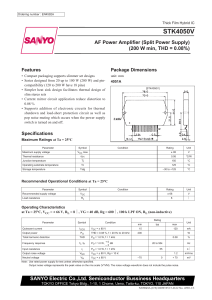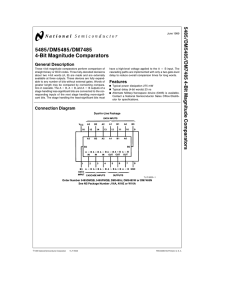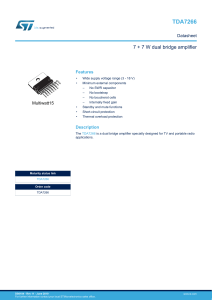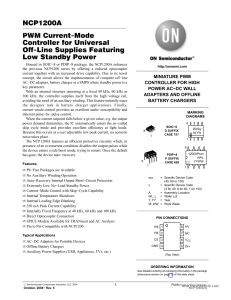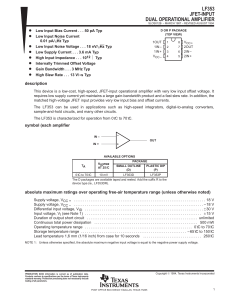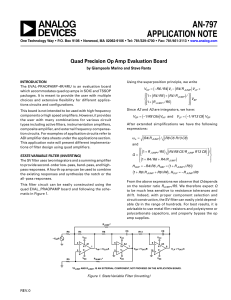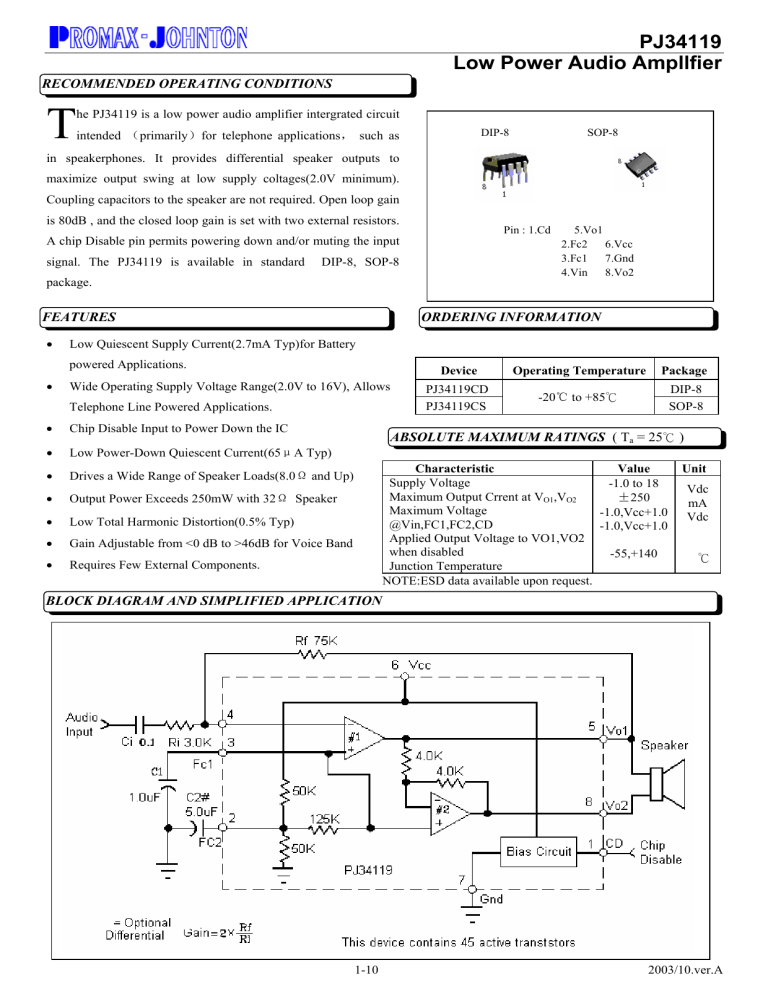
PJ34119 Low Power Audio Ampllfier RECOMMENDED OPERATING CONDITIONS T he PJ34119 is a low power audio amplifier intergrated circuit DIP-8 intended (primarily)for telephone applications, such as SOP-8 in speakerphones. It provides differential speaker outputs to maximize output swing at low supply coltages(2.0V minimum). Coupling capacitors to the speaker are not required. Open loop gain is 80dB , and the closed loop gain is set with two external resistors. Pin : 1.Cd A chip Disable pin permits powering down and/or muting the input signal. The PJ34119 is available in standard DIP-8, SOP-8 package. ORDERING INFORMATION FEATURES • Low Quiescent Supply Current(2.7mA Typ)for Battery powered Applications. • 5.Vo1 2.Fc2 6.Vcc 3.Fc1 7.Gnd 4.Vin 8.Vo2 Wide Operating Supply Voltage Range(2.0V to 16V), Allows Telephone Line Powered Applications. • Chip Disable Input to Power Down the IC • Low Power-Down Quiescent Current(65μA Typ) • Drives a Wide Range of Speaker Loads(8.0Ω and Up) • Output Power Exceeds 250mW with 32Ω Speaker • Low Total Harmonic Distortion(0.5% Typ) • Gain Adjustable from <0 dB to >46dB for Voice Band • Requires Few External Components. Device Operating Temperature Package PJ34119CD PJ34119CS -20℃ to +85℃ DIP-8 SOP-8 ABSOLUTE MAXIMUM RATINGS ( Ta = 25℃ ) Characteristic Value Supply Voltage -1.0 to 18 Maximum Output Crrent at VO1,VO2 ±250 Maximum Voltage -1.0,Vcc+1.0 @Vin,FC1,FC2,CD -1.0,Vcc+1.0 Applied Output Voltage to VO1,VO2 when disabled -55,+140 Junction Temperature NOTE:ESD data available upon request. Unit Vdc mA Vdc ℃ BLOCK DIAGRAM AND SIMPLIFIED APPLICATION 1-10 2003/10.ver.A PJ34119 Low Power Audio Ampllfier Characteristics Supply Voltage Voltage@CD(Pin 1) Load Impedance Peak Load Current Differential Gain (5.0KHz Bandwidth) Ambient Temperature Symbol VCC VCD RL IL AVD TA Min +2.0 0 8.0 0 -20 Max +16 VCC ±200 46 +70 Unit Vdc Vdc Ω mA dB ℃ Min 80 -0.35 Typ >30 0 Max +0.35 Unit MΩ dB dB - 1.5 - MHz 55 250 400 - 0.5 0.5 0.6 1.0 - mW 50 - 12 52 - dB - >70 - dB 1.0 - 1.15 2.65 5.56 1.25 - -30 Vcc-1.0 0.16 0 +30 - -100 -200 100 18 150 25 220 40 2.0 50 90 0.8 175 KΩ - 2.7 3.3 65 4.0 5.0 100 mA mA µA ELECTRICAL CHARACTERISTICS (TA=25℃,unless otherwise noted) Characteristics Symbol AC Input Resistance(@ Vin) Ri Open Loop Gain(Amplifier #1, f<100Hz) AVOL1 Closed Loop Gain(Amplifier #2, Vcc=6.0V,f=1KHz, AV2 RL=32Ω) Gain Bandwidth Product GBW Output Power: Vcc=3.0V,RL=16Ω,THD≤10% Pout3 Vcc=6.0V,RL=32Ω,THD≤10% Pout6 Vcc=12V,RL=100Ω,THD≤10% Pout12 Total Hamonic Distortion(f=1KHz) THD (Vcc=6.0V, RL=32Ω,Pout=125mW) (Vcc≥3.0V, RL=8.0Ω,Pout=20mW) (Vcc≥12V, RL=32Ω,Pout=200mW) Power Supply Rejection(Vcc=6.0V, ∆Vcc=3.0V) PSRR (C1=∞, C2=0.01µF) (C1=0.1µF,C2=0,f=1.0KHz) (C1=1.0µF,C2=5.0µF,f=1.0KHz) Differential Muting GMT (Vcc=6.0V,1.0KHz≤f≤20KHz,CD=2.0V) AMPLIFIERS(DC CHARACTERISTICS) Output DC Level@VO1,VO2, ,RL=16(Rf=75K) VCC=3.0V Vo(3) Vcc=6.0V Vo(6) Vcc=12V Vo(12) Output Level High(Iout=-75mA,2.0≤Vcc≤16V) VOH Low(Iout=75mA, 2.0≤Vcc≤16V) VOL Output DC Offset Voltage(VO1-VO2) ∆Vo (Vcc=6.0V,RL=75KΩ,RL=32Ω) Input Bias Current@Vin(Vcc=6.0V) fIB Equivalent Resistance @FC1(Vcc=6.0V) RFC1 @FC2(Vcc=6.0V) RFC2 CHIP DISABLE(Pin1) Input Voltage Low VIL High VIH Input Resistance(Vcc=VCD=16V) RCD POWER SUPPLY Power Supply Current ICC3 (Vcc=3.0V,RL=∞,CD=0.8V) ICC16 (Vcc=16V,RL=∞,CD=0.8V) ICCD (Vcc=3.0V,RL=∞,CD=2.0V) NOTE:Current into are positive,current out of a pin are negative. 2-10 % Vdc Vdc mV nA KΩ Vdc 2003/10.ver.A PJ34119 Low Power Audio Ampllfier PIN FUNCTION DESCRIPTION Symbol CD Pin 1 FC2 2 FC1 3 Vin 4 Vo1 Vcc GND Vo2 5 6 7 8 Description Chip Distable-Digital input. A Logic”0”(<0.8V) sets normal operation. A logic”I”(≥2.0V)sets the power down mode. Input impedance is nominally 90KΩ A capacitor at this pin increases power supply rejection, and affects turn-on time. This pin can be left open it the capacitor at FC1 is sufficient. Analog ground for the amplifiers. A 1.0µF capacitor at this pin(with a 5.0µF capacitor at Pin 2)provides(typically)52dB of power supply rejection. Turn-on time of the circuit is affected by the capacitor on this pin.This pin can be used as an alternate input. Amplifier input. The input capacitor and resistor set low frequency rolloff and input impedance. The feedback resistor is connected to this pin and Vo1. Amplifier Output #1. The dc level is ≈(Vcc-0.7)/2 DC supply voltage (+2.0V to +16V) is applied to this pin. Ground pin for the entire circuit. Amplifier Output #2. This signal is equal in amplitude, but 180° out-of-phase with that at Vo1. The dc level is≈ (Vcc-0.7V)/2 TYPICAL TEMPERATURE PERFORMANCE (-20°C<TA<+70°C) Function Input Bias Current(@Vin) Total Harmonic Distortion (Vcc=6.0V, RL=32Ω Pout=125mW, f=1KHz) Power Supply Current (Vcc=3.0V, RL=∞,CD=0V) (Vcc=3.0V, RL=∞,CD=2.0V) Typical Change ±40 +0.003 -2.5 -0.03 Units ρA/°C %/ °C μA/°C GENERAL The PJ34119 is a low power audio amplifier capable of low voltage operation (Vcc=2.0V minimum) such as that encountered in line-powered speakerphones. The circuit provides a differential output (Vo1-Vo2) to the speaker to maximize the available voltage swing at low voltages. The differential gain is set by two external resistors. Pins FC1 and FC2 allow controlling the amount of power supply and noise rejection, as well as providing alternate inputs to the amplifiers. The CD pin permits powering down the IC for muting purposes and to conserve power. AMPLIFIERS Referring to the block diagram, the internal configuration consists of two identical operational amplifiers. Amplifier #1 has an open loop gain of ≥80dB(at f≤100Hz), and the closed loop gain is set by external resistor Rf and Rj. The amplifier is unity gain stable, and has a unity gain frequency of approximately 1.5MHz. In order to adequately cover the telephone voice band (300Hz to 3400Hz), a maximum closed loop gain of 46 is recommended. Amplifier #2 is internally set to gain of –1.0(0dB). The outputs of both amplifiers are capable of souring and sinking a peak current of 200mA.The outputs can typically swing to within≈0.4V above ground, and to within≈1.3V below Vcc, at the maximum current. See Figure 18 and 19 for VOH and VOL curves. The output dc offset voltage (Vo1-Vo2) is primarily a function of the feedback resistor (Rf), and secondarily due to the amplifiers’ input offset voltages. The input offset voltage of the two amplifiers will generally be similar for a particular IC, and therefore nearly cancel each other at the outputs. Amplifier #1’s bias current, however, flows out of Vin (pin 4) and through Rf, forcing Vo1 to shift negative by an amount equal to [Rf × IIB] Vo2 is shifted posited an equal amount. The output offset voltage, specified in the Electrical Characteristics is measured with the feedback the feedback resistor shown in the Typical Application Circuit, and therefore takes into account the bias current as wells internal offset voltages of the amplifiers. The bias current is constant with respect to Vcc. 3-10 2003/10.ver.A PJ34119 Low Power Audio Ampllfier FC1 AND FC2 Power supply rejection is provided by the capacitors (C1 and C2 in the typical Application Circuit) at FC1 and FC2. C2 is somewhat dominant at low frequencies, while C1 is dominant at high frequencies , as shown in the graphs of Figure 4 to 7. The required values of C1 and C2 depend on the conditions of each application. A line powered speakerphone, for example, will require more filtering than a circuit powered by a well regulated power supply. The amount of rejection is function of the capacitors , and the equivalent impedance looking into FC1 and FC2 (listed in the Electrical Characteristics as RFC1 and RFC2). In addition to providing filtering, C1 and C2 also affect the turn-on time of the circuit at power-up, since the two capacitors must charge up through the internal 50K and 125 KΩ resistors. The graph of Figure 1 indicates the turn-on time upon application of Vcc of +6.0V. The turn-on time is ≈60% longer for Vcc=3.0V, and ≈20% less for Vcc=9.0V. Turn-off time is <10µs upon removal of Vcc. CHIP DISABLE The chip Disable (Pin 1) can be used to power down the IC to conserve power, or for muting, or both. When at a Logic “0” (0V to 0.8V), the PJ34119 is enabled for normal operation. When Pin 1 is a Logic”1”(2.0V to Vcc V ), the IC is disabled. If Pin 1 is open, that is equivalent to Logic “0” although good design proactive dictates that an input should never be left open. Input impedance at Pin 1 is a nominal 90 KΩ. The power supply current (when disabled) is shown in Figure 15. Muting, defined as the change in differential gain from normal operation to muted operation, is in excess of 70dB.The turn-off time the audio output, from the application of the CD signal, is <2.0µs, and turn on-time is 12 ms-15ms. Both times are independent of C1,C2, and Vcc. When the PJ34119 is disabled, the voltage at FC1 and FC2 do not change as they are powered from Vcc. The outputs, Vo1 and Vo2, change to high impedance condition, removing the signal from the speaker. If signals from other sources are to be applied to the outputs (while disabled), they must be within the range of Vcc and Ground. POWER DISSIPATION Figure 8 to 10 indicate the device dissipation (within the IC) for various combinations of Vcc, RL, and load power. The maximum power which can safely be dissipated within the PJ34119 is found from the following equation: PD=(140°C-TA)/θJA Where TA is the ambient temperature; and θJA is the package thermal resistance (100°C/W for the standard DIP package, and 180°C/W for the surface mount package.) The power dissipated within the PJ34119, in a given application, is found from the following equation:PD=(Vcc×Icc)+(IRMS×Vcc)-(RL×IRMS2) Where Icc is obtained from Figure 15; and IRMS is the RMS current at the load; and RL is load resistance.Figure 8 to 10, along with Figure 11 to 13(distortion curves), and a peak working load current of ±200mA, define the operating range for the PJ34119. The operating range is further defined in terms of allowable load power in Figure 14 for loads of 8.0Ω,16Ω and 32Ω. The left(ascending portion of each of the three curves is defined by the power level at which 10% distortion occurs. The center flat portion of each curve is defined by the maximum output current capability of the PJ34119. The right(descending) portion of each curve is defined by the maximum internal power dissipation of the IC at 25°C. At higher ambient temperatures, the maximum load power must be reduced according to the above equations. Operating the device beyond the current and junction temperature limits will degrade long term reliability. LAYOUT CONSIDERATIONS Normally a snubber is not needed at the output of the PJ34119, unlike many other audio amplifiers, However, the PC board layout, stray capacitances, and the manner in which the speaker wires are configured, may dictate otherwise. Generally, the speaker wires should be twisted tightly, and not more than afew inches in length 4-10 2003/10.ver.A PJ34119 Low Power Audio Ampllfier FIGURE 2.AMPLIFIER #1 OPEN LOOP GAIN AND PHASE Figure 1.Turn-On Time versus C1,C2 at Power-On µ µ µ FIGURE 3.DIFFERENTIAL GAIN VERSUS FREQUENCY FIGURE 4.POWER SUPPLY REJECTION versus FREQUENCY(C2=10µF) µ µ FIGURE 6.Power SUPPLY REJECTION versus FREQUENCY(C2=1.0µF) FIGURE 5.POWER SUPPLY REJECTION versus FREQUENCY(C2=5.0µF) µ µ µ µ µ 5-10 2003/10.ver.A PJ34119 Low Power Audio Ampllfier FIGURE 8.DEVICE DISSIPATION, 8.0Ω LOAD FIGURE 7.POWER SUPPLY REJECTION versus FREQUENCY(C2=0) µ µ µ 0 30 60 90 120 150 FIGURE 9.DEVICE DISSIPATION,16Ω LOAD FIGURE 10.DEVIECE DISSIPATION, 32Ω LOAD FIGURE 11.DISTORTION versus POWER FIGURE 12.DISTORTION versus POWER (f=3.0KHz,AVD=34dB) (f=1.0KHz, AVD=34dB) Ω Ω Ω Ω Ω Ω Ω Ω Ω Ω Ω 6-10 Ω 2003/10.ver.A PJ34119 Low Power Audio Ampllfier FIGURE 14.MAXIMUM ALLOWABLE LOAD POWER FIGURE 13.DISTORTION versus POWER (f=1,3.0KHz, AVD=12dB) Ω Ω Ω Ω Ω Ω Ω Ω Ω 0 2.0 4.0 6.0 8.0 10 12 14 4.0 6.0 8.0 10 12 14 16 FIGURE 16.SMALL SIGNAL RESPONSE FIGURE 15.POWER SUPPLY CURRENT 0 2.0 16 µ FIGURE 18.VCC-VOH @ VO1,VO2 versus LOAD FIGURE 17.LARGE SIGNAL RESPONSE CURRENT µ 7-10 2003/10.ver.A PJ34119 Low Power Audio Ampllfier FIGURE 20.INPUT CHARACTERISTICE @ CD (PIN 1) µ FIGURE 19.VOL @ VO1,VO2 versus LOAD CURRENT FIGURE 21.FREQUENCY RESPONSE OF FIGURE 22 FIGURE 22.AUDIO AM[LIFIER WITH HIGH INPUT IMPEDANCE µ 8-10 2003/10.ver.A PJ34119 Low Power Audio Ampllfier FIGURE 23.AUDIO AMPLIFIER WITH BASE SUPPRESSION µ FIGURE 24.AUDIO AMPLIFIER WITH BANDPASS µ 9-10 2003/10.ver.A PJ34119 Low Power Audio Ampllfier 10-10 DIM A B C D G J K L M MILLIMETERS MIN MAX 9.07 9.32 6.22 6.48 3.18 4.43 0.35 0.55 2.54BSC 0.29 0.31 3.25 3.35 7.75 8.00 10° INCHES MIN MAX 0.357 0.367 0.245 0.255 0.125 0.135 0.019 0.020 0.10BSC 0.011 0.012 0.128 0.132 0.305 0.315 10° DIM A B C D F G K M P R MILLIMETERS MIN MAX 4.80 5.00 3.80 4.00 1.35 1.75 0.35 0.49 0.40 1.25 1.27BSC 0.10 0.25 0° 7° 5.80 6.20 0.25 0.50 INCHES MIN MAX 0.189 0.196 0.150 0.157 0.054 0.068 0.014 0.019 0.016 0.049 0.05BSC 0.004 0.009 0° 7° 0.229 0.244 0.010 0.019 2003/10.ver.A
